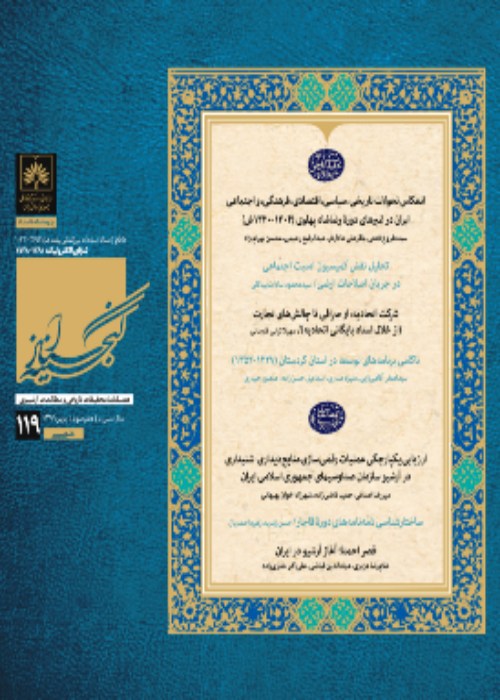فهرست مطالب
فصلنامه گنجینه اسناد
پیاپی 53 (بهار 1383)
- 108 صفحه، بهای روی جلد: 12,000ريال
- تاریخ انتشار: 1383/03/20
- تعداد عناوین: 13
-
صفحه 3
-
صفحه 4
-
صفحه 87
-
صفحه 96
-
صفحه 97
-
چکیده مقالات به انگلیسیصفحه 104
-
Page 4Historians should resort to records in order to extract historical facts. But, unfortunately they put more importance on record's age than their credibility. This can question the reliability of documents, on which a historian is working on. The article has reviewed some records on Ferdowsi, and has showed the necessity of re-considering historical records.
-
Page 12Lady Kasraeel, daughter of Naserddin Shah was born by one of the shah's concubine wives, namely Effat Al Saltane in 1856. She is the one who had born to Masoud Mirza Zel Al Sultan in 1850. Lady kasraeel was then nicknamed Eftekhar Al Dowle, and married to Abol fath khan Sarem Al Dowle, son of Yereven's Brigadier General Hasan Khan, and Lady Mah Rokhsar Fakhr Al Dowle, daughter of prince Abbas Mirza. EftekharAl Dowle was living in Esfahan and her husband, Sarem Al Dowle was an influenced man in Zel Al Sultan governorship, as well as a well-to-do man, in the city. In 1882, four daughter of Zel Al Sultan married to four sons of Eftekhar Al Dowle in the same day, explained in this article. In 1889, Eftekhar Al Dowle was nicknamed as " Grand Lady", and in 1887, her husband was murdered by direct order of Zel Al Sultan. She then married no other man, and lived with her brother in Esfahan. Records, which brought forth at the end of the article, are about a dispute between Grand Lady and then Minister of Finance, over her estates.
-
Page 22While re-reading the endowment letter, the author explains and analyses Rokn Al Mulk's endowment letter, who was deputy to governor of Esfahan. As a unique record, and due to frequent reference to it in Esfahan's policy-making, the document should be taken as an important one. Who was Rokn Al Mulk, and what was his objective of the endowment? how many properties did he endow and who was supervising his benevolence measures? These are the issues discussed at the article.
-
Page 39Charitable activities, as a social issue have been considered a routine by benevolent people. In Iran, this has been traced in old days, before accepting Islam as an official religion by the People and the State.Qajars1 period, as the author says, has left deep effects on setting up charities. According to charitable acts and its status in Rasht, she has studied significant factors, influencing those institutions. Records, as a major source, have drawn up popular activities of the people in Rasht.Rasht was a cradle of intelectuals who were in touch with foreign countries, and were taking frequent travels outside. Their repatriation to the homestead created developments, including establishment of charities as a rule-based event. Therefore, Rasht is counted as the birthplace of charitable ideas, which has been taken based on records.
-
Page 54At the onset of 1340s, in Iranian calender year (1961) because of gradual developments in sylabuses of Iran's elementary and senior highschool levels, the books were considered to be revised, and improved in different stages of publication and distribution. The collected records in this article, show aspects of those two procedures.Among the records, number 2 is a survey on school's books, written by Dr. Mohammad Amin Riahi, Director General to Minister of Culture in 1962. The author reveals important points on the school's books, which is of crucial importance, for it introduces features of modern schooling in Iran.
-
Page 59The article has dug into working conditions, tax payment, and general circumstances of tailors and hat makers in Sonqor & Koliaiee region between 1924 -1926. In mid 19th century, and after extensive economic ties between Iran and western Europe, a new economic, social and political condition for Iranian professions began to emerge. Now we glance at the mentioned careers in western Iran in a case study and based on the records remained from that time span.
-
Page 73At the article, the hazardous elements in the repositories have been introduced and preventive measures were brought up by the author. Damages to records break up into three major physical, biological and chemical ones such as below: -Physical destruction, which comes from heat, humidity, light and dust -Biological elements: micro-organisms, bacteria, fungi, moulds, insects and rodents -Chemical damages include: chemical reactions upon paper, vellum, etc. Those chemical reactions would occur while getting papers, covers, and non-cellulose fibers ironed or when additives add up to paper.Taking correct preventive measures, one can take away those harmful factors, and simply protect his records.
-
Page 84In 1998, International Council on Archives emphasized on setting up a data base on CIS countries archives and related mechanisms to develop them. Therefore, an exhaustive questionnaire was drawn up, and appropriate data were collected from 10 breakaway republics of former Soviet Union. A book, namely " An analytic study of archives in CIS countries ", is the consequence of those data-gathering, which was published in English. Because it covers wide range of issues, parts of the book, will be appeared in this quarterly in sequence. The first two parts blanket titles, respecting archive's rules and management in the governmental system. Ensuing part is another section of the book.


